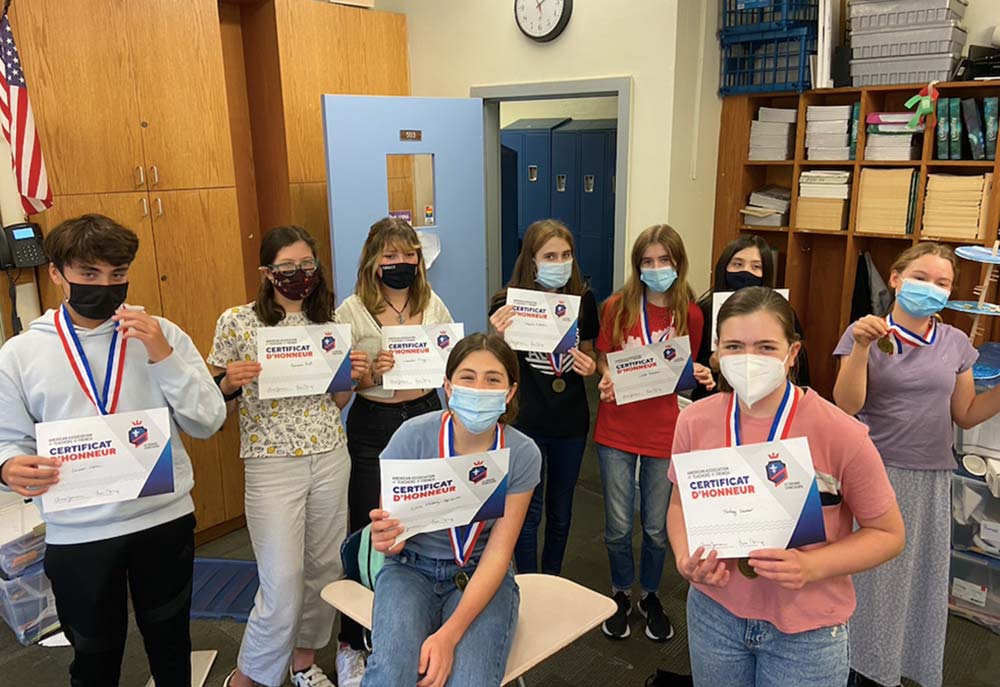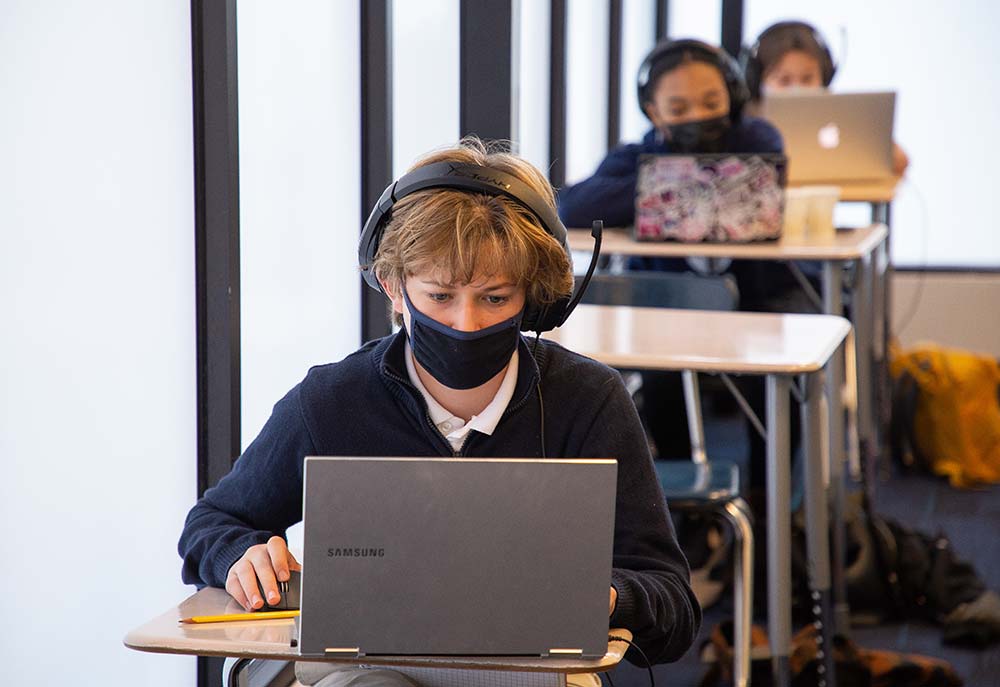Robust Academics in an Unusual Year
The hallmark of this success is that despite the many changes to the structure of the school day, students in every division continued to meet important benchmarks for learning and growth. In Early Childhood, students learned about “popcorn words” to improve their sight reading and studied the life cycle by raising and releasing butterflies. Teachers also continued to use the Bridges Math Curriculum to inspire students up through Grade 4 to think like mathematicians. In Middle School, eighth graders earned awards in the national le Grand Concours French contest, and students bonded through grade-level spring field trips to Six Flags, Governor’s Island and New York Harbor. High School students accomplished academic milestones, such as the sophomore March Madness projects and the 25-page senior humanities papers, both of which were presented virtually. And at every grade, arts faculty devised new strategies to nurture the artist, musician and dancer within each student.
In Early Childhood, chapel services were pre-recorded and watched together by cohorts on Wednesday mornings; families received a link to these videos, so that remote students could watch alongside their classmates. We heard from many families that they also shared these links with cousins, grandparents, and other family members because the videos helped them feel connected to each other, as well as to our school. Head of Early Childhood Cheryl Kelly summed up the year perfectly to students in Junior Kindergarten through Grade 1 at a chapel talk in April: “This year was a tricky year—it was very different for all of us. But we never gave up. We gave our best.”
Head of Lower School Randall Flinn says that her team spent extra time this year reviewing individual student learning profiles to ensure academic and social emotional learning. Lower School teachers provided differentiated instruction in classrooms, helped students connect through friendship groups organized around topics of common interest and collaborated with the Office of Community Engagement to introduce antiracism lessons from the Pollyanna Racial Literacy Curriculum. The weekly chapel service, presented live and in real-time online, reinforced for students in Grades 2-4 that everyone was sharing the experience of this year together. “We heard from parents throughout the year about how their children felt supported,” Ms. Flinn says. “That is the foundation of learning.”
The constrictions of time and space instigated by the pandemic also prompted faculty to take a fresh look at what core concepts and skills we want students to acquire within each subject. Building off of this work, Lower School faculty have been revisiting the social studies curriculum and mapping out an exciting new set of process-oriented units that emphasize the “why” behind the learning.
Middle School faculty engaged in a similar process last summer, which paved the way for a successful year of hybrid learning. Recognizing that less can be more, for example, fifth grade teachers assigned students only one research paper, rather than two, and spent more time scaffolding the essential research and writing skills involved. Giving students more in-depth feedback on one paper led to better writing and revising. Other techniques that will carry into the future include scheduling individual music lessons during middle schoolers’ study halls to reinforce the skills taught in class. Teachers tried this approach this year because safety guidelines prevented young musicians from sharing air space—and “they saw more growth than ever before,” says Middle School Head Elsa Hepner. Teachers brought such creativity across every subject. “By focusing on the process in thoughtful ways,” Ms. Hepner says, “every teacher felt confident that the academics were happening.”
The Middle School also made strategic use of space to enhance opportunities for student interaction and create a more equitable environment for students during hybrid learning. “The Broadway,” which is now being converted into three classrooms for ongoing use, was invaluable as a place for middle schoolers to socialize and maintain focus during remote school days. “This space helped students make that mental shift into school mode,“ Ms. Hepner says. In addition, teachers used the outdoor space on 10th Street and the play yard to demonstrate science experiments, to gather band members for safely distanced, in-person rehearsals and for gym class, as well as recess and lunch.
“It’s a major success that we covered the curriculum without missing a step,” says Head of High School Hugo Mahabir. “Students are coming into the next year fully prepared to take on the next level of challenge.” In the High School, Mr. Mahabir attributes this success to the core infrastructure of the program. Having students meet in advisory every day—whether they are on campus or remote—was a stabilizing force. Similarly, the student publication The Grace Gazette, took on an increasingly important role in unifying our community. Faculty and students also conceived of unique ways to connect to our surrounding city, including podcasts created by juniors and seniors in the NYC History elective and “A Guide to Getting Through,” in which Grace Theatre Company filmed musical scenes in various locations around Manhattan, Brooklyn and New Jersey.
As part of reorganizing the High School schedule to accommodate hybrid learning, we also offered six Community Weeks that emphasized social and emotional learning and introduced some welcome variety to the school year. These weeks were filled with student-driven programming around sustainability, social justice, health and self-care, the arts as well as other themes. Through these and other initiatives, High School students engaged in conversations about relational and restorative justice, responding to calls from the community to deepen the school’s commitment to antiracism. A particularly effective technique in these dialogues was Circle Practice, a First Nations tradition in which participants form a circle and take turns speaking and listening to one another, with each person having equal time, without interruption. “This communication process gives everyone a sense that their experience is recognized,” Mr. Mahabir says, “which has a remarkable effect.”
To celebrate student accomplishments throughout this challenging year, Grace has assembled a Showcase of Academic Excellence on its website that features videos, photos, and documents highlighting student work in each division. From Lower School students singing “Do the Good You Know,” to eighth graders graphing geometric drawings with Desmos software, to seniors writing impressive essays, Assistant Head of School and Director of Studies Robbie Pennoyer sees these highlights as evidence of how much students love learning. “My colleagues have always impressed me with their ability to harness students’ desire to create something they are proud of,” he says. “Our faculty are always thinking about how to make the doing of learning more meaningful for students. And they always approach their classes with an intense desire to serve.”


